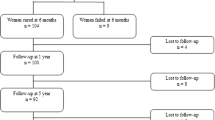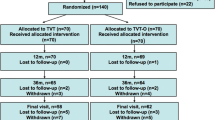Abstract
The aim of this randomized clinical trial was to compare the cure rate and the rate of complications of the tension-free vaginal tape (TVT) with those of the tension free vaginal tape obturator (TVT-O) procedure after one year of follow-up. The study was powered to show a ten per cent difference in cure rate and/or rate of complications. Of the initially treated 267 women 134 in the TVT group and 131 in the TVT-O group were evaluated. A cough stress test and a 24 h pad test were used as objective outcome measures. Subjective outcome was assessed by different condition-specific quality of life questionnaires and general health by the EQ-5D questionnaire. Objective cure rate was 95.5% in the TVT patients and 93.1% in TVT-O patients. Subjective cure rates showed significant improvement at one the year follow up in both groups. No significant differences in cure rates between groups were seen. The complication rate was equal in both groups.

Similar content being viewed by others
References
Ulmsten U, Petros P (1995) Intravaginal slingplasty (IVS): an ambulatory surgical procedure for treatment of female urinary incontinence. Scand J Urol Nephrol 29(1):75–82
Ulmsten U, Henriksson L, Johnson P, Varhos G (1996) An ambulatory surgical procedure under local anesthesia for treatment of female urinary incontinence. Int Urogynecol J Pelvic Floor Dysfunct 7(2):81–86
Nilsson CG, Kuuva N, Falconer C, Rezapour M (2001) Long-term results of the tension-free vaginal tape (TVT) procedure for surgical treatment of female stress urinary incontinence. Int Urogynecol J Pelvic Floor Dysfunct 12(Suppl 2):S5–S8
Kuuva N, Nilsson CG (2003) Tension-free vaginal tape procedure: An effective minimally invasive operation for the treatment of recurrent stress urinary incontinence? Gynecol Obstet Investig 56(2):93–98
Rezapour M, Falconer C, Ulmsten U (2001) Tension-free vaginal tape (TVT) in women with mixed urinary incontinence—a long-term follow-up. Int Urogynecol J Pelvic Floor Dysfunct 12 (Suppl 2):S15–S18
Nilsson CG, Falconer C, Rezapour M (2004) Seven-year follow-up of the tension-free vaginal tape procedure for treatment of urinary incontinence. Obstet Gynecol 104(6):1259–1262
Kuuva N, Nilsson CG (2002) A nationwide analysis of complications associated with the tension-free vaginal tape (TVT) procedure. Acta Obstet Gynecol Scand 81(1):72–77
Tamussino K, Hanzal E, Kölle D, Ralph G, Riss P (2001) Tension-free vaginal tape operation: results of the Austrian registry. Obstet Gynecol 98:732–736
Leboeuf L, Tellez C, Ead D, Gousse A (2003) Complication of bowel perforation during insertion of tension-free vaginal tape. J Urol 170(4):1310–1311
Amna MB, Randrianantenaina A, Michel F (2003) Colic perforation as a complication of tension-free vaginal tape procedure. J Urol 170(6):2387
Zilbert AW, Farrell SA (2001) External iliac artery laceration during tension-free vaginal tape procedure. Int Urogynecol J Pelvic Floor Dysfunct 12(2):141–143
Vierhout ME (2001) Severe hemorrhage complicating tension-free vaginal tape (TVT): a case report. Int Urogynecol J Pelvic Floor Dysfunct 12(2):139–140
Delorme E (2001) Transobturator urethral suspension: a minimally invasive procedure to treat female stress urinary incontinence. Prog Urol 11(6):1306–1313
de Leval J (2003) Novel surgical technique for the treatment of female stress urinary incontinence: transobturator vaginal tape inside-out. Eur Urol 44(6):724–730
Laurikainen E, Valpas A, Kivelä A, Kalliola T, Takala T, Nilsson CG et al (2007) Retropubic compared with transobturator tape placement in treatment of urinary incontinence: a randomized controlled trial. Obstet Gynecol 109(1):4–11
Stach-Lempinen B, Kujansuu E, Laippala P, Metsänoja R (2001) Visual analogue scale, urinary incontinence severity score and 15 D-psychometric testing of three different health-related quality-of-life instruments for urinary incontinent women. Scand J Urol Nephrol 35(6):476–483
Kauppila A, Alavaikko P, Kujansuu E (1982) Detrusor instability score in the evaluation of stress urinary incontinence. Acta Obstet Gynecol Scand 61(2):137–141
Uebersax J, Wyman J, Shumaker S, McClish D, Fantl J (1995) Short forms to assess life quality and symptom distress for urinary-incontinence in women: the incontinence impact questionnaire and the urogenital distress inventory. Neurourol Urodyn 14(2):131–139
Sintonen H (2001) The 15D instrument of health-related quality of life: properties and applications. Ann Med 33(5):328–336
Stach-Lempinen B (2004) Health-related quality of life and female urinary incontinence. Acta Universitatis Tamperensis 1012. ISBN 951-44-5981-4
Laurikainen E (2006) Tension-free vaginal procedures for female stress urinary incontinence. Annales Universitatis Turkuensis, Ser. D. Medica-Odontologica 724.ISBN 951-29-3140-0
Dean N, Herbison P, Ellis G, Wilson D (2006) Laparoscopic colposuspension and tension-free vaginal tape: a systematic review. BJOG 113(12):1345–1353
Valpas A, Kivela A, Penthnen J, Kauko M, Kujansuu E, Nilsson CG et al (2003) Tension-free vaginal tape procedure and laparoscopic colposuspension in the treatment of stress urinary incontinence. Acta Obstet Gynecol Scand 82:665–671
Ward K, Hilton P (2004) A prospective multicenter randomized trial of tension-free vaginal tape and colposuspension for primary urodynamic stress incontinence: two-year follow-up. Am J Obstet Gynecol 190(2):324–331
Liapis A, Bakas P, Giner M, Creatsas G (2006) Tension-free vaginal tape versus tension-free vaginal tape obturator in women with stress urinary incontinence. Gynecol Obstet Invest 62(3):160–164
Zullo MA, Plotti F, Calcagno M, Marullo E, Palaia I, Bellati F et al (2007) One-year follow-up of tension-free vaginal tape (TVT) and trans-obturator suburethral tape from inside to outside (TVT-O) for surgical treatment of female stress urinary incontinence: a prospective randomised trial. Eur Urol 51(5):1376–1384
Lim J, Cornish A, Carey M (2006) Clinical and quality-of-life outcomes in women treated by the TVT-O procedure. BJOG 113(11):1315–1320
Boustead GB (2002) The tension-free vaginal tape for treating female stress urinary incontinence. BJU Int 89(7):687–693
Schleupner CJ (1997) Urinary track infections. Postgrad Med 101(6):231–237
Alcalay M, Monga A, Stanton SL (1995) Burch colposuspension: a 10–20 year follow up. BJOG 102(9):740–745
Dietz HP, Wilson PD (2000) Colposuspension success and failure: a long-term objective follow-up study. Int Urogynecol J Pelvic Floor Dysfunct 11(6):346–351
Kölle D, Tamussino K, Hanzal E, Tammaa A, Preyer O, Bader A et al (2005) Bleeding complications with the tension-free vaginal tape operation. Am J Obstet Gynecol 193(6):2045–2049
Meschia M, Pifarotti P, Bernasconi F, Guercio E, Mattiolini M, Magatti F et al (2001) Tension-free vaginal tape: analysis of outcomes and complications in 404 stress incontinent women. Int Urogynecol J Pelvic Floor Dysfunct 12(Suppl 2):S24–S27
Miller J-J, Botros S, Akl M, Aschkenazi S, Beaumont J, Sand P et al (2006) Is transobturator tape as effective as tension-free vaginal tape in patients with borderline maximum urethral closure pressure? Am J Obstet Gynecol 195(6):1799–1804
O’Connor R, Nanigian D, Lyon M, Ellison L, Bales G, Stone A (2006) Early outcomes of mid-urethral slings for female stress urinary incontinence stratified by valsalva leak point pressure. Neurourol Urodyn 25:685–688
Conflicts of interest
None.
Author information
Authors and Affiliations
Corresponding author
Rights and permissions
About this article
Cite this article
Rinne, K., Laurikainen, E., Kivelä, A. et al. A randomized trial comparing TVT with TVT-O: 12-month results. Int Urogynecol J 19, 1049–1054 (2008). https://doi.org/10.1007/s00192-008-0581-3
Received:
Accepted:
Published:
Issue Date:
DOI: https://doi.org/10.1007/s00192-008-0581-3




